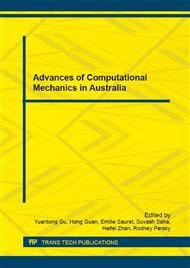[1]
L. Hollaway and M. Leeming, Strengthening of reinforced concrete structures, London, Woodhead Publishing, (1999).
Google Scholar
[2]
M. Arduini, A. Tommaso and A. Nanni, Behavior of precracked RC beams strengthened with carbon FRP sheets, Journal of Composites for Construction. 1(1997) 63-70.
DOI: 10.1061/(asce)1090-0268(1997)1:2(63)
Google Scholar
[3]
A.S. Bouchikhi, A. Lousdad, and A. Megueni, On the reduce of interfacial shear stresses in fiber reinforced polymer plate retrofitted concrete beams, Materials and Design, 31(2010) 1508-1515.
DOI: 10.1016/j.matdes.2009.08.006
Google Scholar
[4]
S. Hashemi, R. Rahgozar and A. Maghsoudi, Finite element and experimental serviceability analysis of HSC beams strengthened with FRP sheet, American Journal of Applied Science, 4(9)(2007) 725-735.
DOI: 10.3844/ajassp.2007.725.735
Google Scholar
[5]
S. Radfar, G. Foret, and K. Sab, Failure mode analysis of fibre reinforced polymer plated reinforced concrete beam, 6th International Conference on FRP Composites in Civil Engineering, June 2012, Italy.
Google Scholar
[6]
M. C. Sundarraja and S. Rajamohan, Flexural strengthening effect on RC beams by bonded composite fabric, Journal of reinforced Plastics and Composites, 27 (14)(2008) 1497-1513.
DOI: 10.1177/0731684407081377
Google Scholar
[7]
Bo Gao, Jang Kyo Kim, and Christopher K. Y Leung, Experimental study on RC beams with FRP strips bonded with rubber modified resin, Composites Science and Technology, 64 (16)(2004) 2557–2564.
DOI: 10.1016/j.compscitech.2004.05.016
Google Scholar
[8]
S. F. Brena, R. M. Bramblett, S. L. Wood and M. E. Kreger, Increasing flexural capacity of reinforced concrete beams using carbon fiber-reinforced polymer composite, ACI Struct. J., 100(1)(2003), 36–46.
DOI: 10.14359/12437
Google Scholar
[9]
Z. Wu and H. Niu, Numerical analysis of debonding mechanisms in FRP-strengthened RC beam, Computer-Aided Civil and Infrastructure Engineering, 20(2005) 354-368.
DOI: 10.1111/j.1467-8667.2005.00402.x
Google Scholar
[10]
H. D. Niu and Z. S. Wu, Peeling-off criterion for FRP strengthened R/C flexural member, In Proceedings of International Conference on FRP Composites in Civil Engineering, Hong Kong, 1(2001) 571–578.
Google Scholar
[11]
A. M. Sayed, X. Wang, and Z. Wu, Finite element modeling of the shear capacity of RC beams strengthened with FRP sheets by considering different failure modes, Construction and Building Materials, 59(2014) 169-179.
DOI: 10.1016/j.conbuildmat.2014.02.044
Google Scholar
[12]
J. G. MacGregor and J. K. Wight, Reinforced concrete mechanics and design. Prentice-Hall, Inc., Englewood Cliffs, NJ, (1992).
Google Scholar
[13]
X.Z. Lu, J.G. Teng, L. P. Ye, and J.J. Jiang, Bond slip models for FRP sheets/plates bonded to concrete, Engineering Structures, 27(2005) 920-937.
DOI: 10.1016/j.engstruct.2005.01.014
Google Scholar
[14]
M. Molina, J. J. Cruz, S. Oller, A. Barbat, H. Alex, and L. Gil, Behaviour of the interface between concrete and FRP using serial/parallel mixing theory, Ing. Investig., 31(3)(2011) 26-39.
DOI: 10.15446/ing.investig.v31n3.26375
Google Scholar
[15]
P. Pathak and Y. X. Zhang, Nonlinear finite element analysis of FRP strengthened RC beams, 8th International structural engineering and construction conference, 2015, Sydney.
DOI: 10.14455/isec.res.2015.115
Google Scholar
[16]
C. Nitereka and K. W. Neale, Analysis of reinforced concrete beams strengthened in flexure with composite laminates, Can. J. Civ. Eng., 26(5)(1999) 646–654.
DOI: 10.1139/l99-026
Google Scholar
[17]
C. F. Coronado and M. M. Lopez, Sensitivity analysis of reinforced concrete beams strengthened with FRP laminate, Cem. Concr. Compos., 28(1)(2006) 102–114.
DOI: 10.1016/j.cemconcomp.2005.07.005
Google Scholar
[18]
ANSYS 13. 0 [Computer software]. Canonsburg, PA, ANSYS.
Google Scholar


